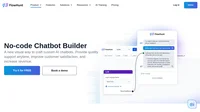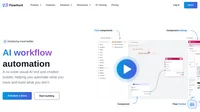Customer Service Automation is the application of technology to manage customer inquiries and service tasks with minimal human intervention. This technology employs tools such as AI, chatbots, self-service portals, and other automated systems to streamline customer interactions, resolve issues, and improve service efficiency. By automating certain aspects, businesses ensure that no query is missed, every customer receives timely and effective support, and service processes are more organized and efficient.
Purpose:
The primary goal of customer service automation is to enhance efficiency by reducing the workload on human agents, allowing them to focus on more complex and high-value customer interactions. This leads to faster response times, improved customer satisfaction, and reduced operational costs. According to Gartner, by 2025, 75% of organizations will have implemented some form of customer service automation, underscoring its growing importance in meeting modern consumer expectations for speed and accessibility.
Key Components:
- Chatbots and Virtual Assistants: AI-powered chatbots use natural language processing (NLP) to understand and respond to customer queries, guiding them through basic troubleshooting and information retrieval. They provide 24/7 assistance, significantly improving response times and customer satisfaction.
- Interactive Voice Response (IVR): Automated phone systems interact with callers, gather information, and route calls to the appropriate department or agent. This reduces wait times and ensures queries are directed efficiently.
- Self-Service Portals: Platforms where customers can access FAQs, how-to guides, and troubleshooting materials to solve issues independently. These are crucial for offering round-the-clock support and empowering customers to find solutions without direct interaction.
- Automated Email Responses: Systems that analyze incoming emails, provide pre-written responses, or escalate them to human agents if necessary. They ensure that every email is acknowledged and handled appropriately, reducing response times and improving efficiency.
- Ticket Routing and Prioritization: Automation tools categorize and prioritize support tickets based on urgency or customer type, ensuring high-priority issues are addressed promptly. This optimizes resource allocation and enhances customer service quality.
- Workflow Automation: Automating repetitive tasks such as updating customer records and sending follow-up emails, freeing human agents for more complex tasks. This streamlines operations and boosts productivity.
- Integration with CRM Systems: Automation tools that integrate with customer relationship management (CRM) software provide personalized service by utilizing customer data. This enhances the ability to deliver tailored customer experiences and build stronger relationships.
Benefits:
- Improved Efficiency: Streamlines processes, allowing human agents to focus on complex tasks while automation handles routine inquiries. This leads to quicker resolutions and more efficient service delivery.
- 24/7 Availability: Offers round-the-clock support, enhancing customer satisfaction by providing instant solutions. Automated systems ensure customers receive assistance at any time, regardless of business hours.
- Cost Reduction: Reduces the need for a large support staff, cutting operational costs significantly. Automation allows companies to scale operations without a proportional increase in staffing costs.
- Enhanced Customer Experience: Provides consistent and rapid responses across multiple channels, improving overall customer satisfaction. Personalizing interactions at scale becomes feasible, fostering loyalty and trust.
- Data-Driven Insights: Automation tools collect and analyze customer interaction data, offering insights for continuous improvement. Real-time analytics enable data-driven decision-making and proactive service enhancements.
Challenges:
- Lack of Human Touch: Automated systems can feel impersonal, lacking the empathy required to handle frustrated customers. Balancing automation with human interaction is crucial to maintaining customer trust.
- Complex Issue Resolution: Automation struggles with complex queries that require human intuition and understanding. Effective escalation processes must be in place to handle such scenarios.
- Resource Intensive: Implementing advanced automation technologies requires significant investment and technical resources. Organizations need to carefully plan and allocate resources for successful deployment.
- Over-Reliance on Technology: Excessive dependence on automation can weaken customer relationships if not balanced with human interaction. Companies must ensure that automation complements rather than replaces human service.
Use Cases:
- Retail: Automating order status inquiries and product information through AI chatbots to enhance customer service efficiency. This reduces workload on human agents and improves customer satisfaction.
- Healthcare: Using chatbots for scheduling appointments and providing basic health information, freeing up staff for more critical tasks. Automation enhances service accessibility and efficiency in healthcare settings.
- Travel Industry: Automating booking modifications and customer inquiries to streamline operations and improve customer satisfaction. This ensures seamless service delivery and enhances the travel experience.
Best Practices:
- Identify Automation Opportunities: Analyze customer service workflows to identify tasks suitable for automation. Focus on repetitive, time-consuming tasks that can be efficiently managed by technology.
- Choose the Right Tools: Select automation technologies that align with business needs and integrate seamlessly with existing systems. Ensure that tools are scalable and adaptable to evolving service requirements.
- Balance Automation and Human Interaction: Ensure clear guidelines for escalating complex issues to human agents to maintain customer trust and satisfaction. Strive for a harmonious blend of technology and human touch.
- Continuous Monitoring and Optimization: Regularly assess and refine automation processes to enhance performance and customer experience. Monitor key metrics and gather feedback to drive ongoing improvements.
Future of Customer Service Automation:
The future of customer service automation is poised to be more intelligent and human-centric, leveraging advancements in AI and machine learning to provide highly personalized and efficient customer interactions. As technology evolves, businesses will increasingly adopt automation to meet growing customer expectations for rapid and seamless service delivery. The integration of conversational AI and AI workflow systems will further enhance the capabilities of automated customer service, enabling more sophisticated and context-aware interactions.
Conclusion:
Customer service automation represents a transformative shift in how businesses interact with customers, offering numerous benefits in terms of efficiency, cost savings, and customer satisfaction. However, successful implementation requires careful planning, the right technological tools, and a strategic approach that balances automation with the human touch. By embracing automation thoughtfully, businesses can enhance their service offerings and build stronger, more satisfying customer relationships.
Customer Service Automation: A Glimpse into Recent Scientific Advancements
Customer service automation is a rapidly evolving field, leveraging advancements in technology to enhance customer interactions. Recent scientific studies provide valuable insights into this domain.
- In the paper titled “How May I Help You?”: Modeling Twitter Customer Service Conversations Using Fine-Grained Dialogue Acts, researchers Shereen Oraby et al. explore the use of dialogue acts in automating customer service on Twitter. They develop a taxonomy tailored for customer service, employing a sequential SVM-HMM model to predict dialogue acts in real time. Their findings suggest that specific dialogue acts influence customer satisfaction and problem resolution outcomes significantly. Read more
- The study “AdaCoach: A Virtual Coach for Training Customer Service Agents” by Shuang Peng et al. introduces AdaCoach, a virtual coach designed to train customer service agents through human-computer interaction. This system simulates real customer interactions and uses automated dialogue evaluation to enhance agent training. AdaCoach has successfully trained over 1,000 agents, highlighting its potential as an innovative training tool. Read more
- Keivalya Pandya and Mehfuza Holia present “Automating Customer Service using LangChain: Building custom open-source GPT Chatbot for organizations.” This research emphasizes the integration of Large Language Models to transform customer service, moving away from traditional methods like FAQs. Their open-source framework, “Sahaay,” demonstrates scalability and the ability to provide real-time, context-aware customer support across various industries. Read more
These studies underscore the transformative potential of automation in customer service, offering frameworks and tools to improve efficiency and customer satisfaction.
Build Your AI Customer Service
Build custom AI chatbots with FlowHunt! Reflect your brand's voice, capture leads, and boost customer satisfaction. Try it free today!



